Here is another of our Guest Blog series – planetary astronomer and CosmoQuest team member Larry Lebofsky introduces us to an interesting impact-created rock known as Saffordite.
As a planetary astronomer who has had a long career studying small bodies in the Solar System— from the dwarf planets to asteroids to moons to the rings of Saturn—I have always had an interest in meteorites, rocks from space. I have been fortunate enough to have hunted for meteorites about six times, but unfortunately have never found any. Maybe someday…. However, I have hunted more successfully for other unusual rocks.
First, here is a little background. A rock in space that orbits the Sun and is smaller than a planet or dwarf planet is called an asteroid. If it is smaller than about a meter (a little over a yard) in diameter, it is called a meteoroid. If the object looks fuzzy when viewed through a telescope, it is called a comet. Once in a while, one of these runs into the Earth. As it passes through Earth’s atmosphere, the light that we see is called a meteor or, if really bright, a fireball. If it is big enough to survive passage through the atmosphere, and we find it, it is called a meteorite.
We have meteorites from asteroids, Mars, and the Moon. There may be a class of meteorites from Mercury, but there is no agreement on this. There is general agreement that we do not have any meteorites from comets. They are just too fragile to survive passage through Earth’s atmosphere. If the incoming object is REALLY big, it will create a crater and the resulting explosion produces enormous amounts of energy. The impacting body, an asteroid or comet, vaporizes on impact, alters the surrounding rocks, and may cause a lot more damage. Ask the dinosaurs about the one that hit 65 million years ago!
One of the byproducts of these big impacts is Earth material that has been melted or vaporized, tossed out of Earth’s atmosphere, and quickly solidified as it reenters the Earth’s atmosphere. We call these impact rocks tektites. We find them in a few places around the world and in most cases we have found the impact crater associated with them. Moldavites in eastern Europe (Ries crater in Germany), Australites and Indochinites in southeast Asia and Australia (no crater conclusively identified), and Bediasites and Georgiates in southeast United States (Chesapeake Bay impact crater) are several examples.
However, there is another class of rocks that look like tektites, but have been shown compositionally and structurally not to be tektites but in fact weathered Earth rocks. When volcanic rock cools fairly quickly, it makes a dark rock called obsidian. Because it cools so quickly, it forms a glass (no crystalline structure). As this rock weathers over tens of millions of years, it absorbs some water, loses it glass-like nature, and fractures into roundish rocks that look a lot like tektites, but they are not!
To give equal time to other theories, if you Google “Saffordite,” you will find another, much more interesting origin for them. “Millions of years ago star beings from Sirius brought Saffordite to the king of the world Sanat Kumar and to the priests of Shambhala to establish on earth civilization of peace and harmony.” “It must be right, it is on the Web!”
You can buy Saffordites on the Web, but the person who personally collects and sells them is presently sold out. To his credit, he does say that he thinks that they are of terrestrial origin, but has not been able to find their source. I am not a dealer, I just collect them.
There are other similar weathered volcanic rocks found in other parts of the world. In all cases, they are chemically and physically similar to volcanic obsidian glass and not tektites.
To complete the list of pseudotektites, there are other impact rocks that have formed in place and are “just” impact-melted Earth rock that has fused into a glass. These are Libyan Desert glass found in the Libyan Desert, and Darwin glass found in Tasmania. A crater has been identified on the island of Tasmania (Australia) that appears to be the source of the Darwin glass.
Finally, to my trips to the location of the Saffordites. The area where I have hunted is east of Mt Graham and southeast of the city of Safford in southeast Arizona, several hours east of Tucson. It is a fairly flat area and the known area where Saffordites have been found covers many square miles, maybe tens or hundreds of square miles. Since these are many million-year-old weathered volcanic rocks, they may have been transported to their present location, so their source is unknown. As it turns out, this location is on my way to observing at the Vatican Advanced Technology Telescope on 10,000-foot Mt. Graham, but that is another story.
Here are three pictures taken just before we started looking for Saffordites. On the left is me with Twink Monrad. Twink is the person who got me interested in Saffordites. She hunts for terrestrial and extraterrestrial rocks as well as coins, jewelry, etc. She is very successful with all of these. Her claim to fame is that she is one of three people who were asked to map out the newly-discovered Gold Basin meteorite strewn field in 1995.
Being a desert area, it can be very warm, even in winter. One has to watch out for wildlife. Luckily, I have never come across a snake there, just a few rabbits and lizards. However, there are others out there that you need to be aware of, Mr. Park Ranger! Both times there, within minutes of our arriving at our hunting sites, we were greeted by the Forest Service just trying to make sure that we were not “visiting” from Mexico or carrying out a drug deal.
What you need for a safe and successful hunt is sunscreen, a good hat, sunglasses (though sometimes it is easier to spot the little black rocks without your sunglasses), lots of water, and an LED flashlight. The good Saffordites will be translucent. I will admit that I do not know if the difference between those that translucent and those that are opaque is due to a chemical or physical difference.
It takes a little time and practice to find your first few Saffordites. You are looking for a black rock among thousands of other-colored rocks. It was good to have a patient and helpful Twink there! “Ok, stand right there and look that way. There is a nice Saffordite right in front of you.” At first you think she is joking, but eventually you see it and get the hang of finding your own. Use the following pictures to determine “where’s the Saffordite?”
Here are the “answers.”
In two trips I have found well over a hundred Saffordites. Most of them are the ones that are translucent. I collect both and Twink is kind enough to give me her rejects. They are still very interesting rocks.

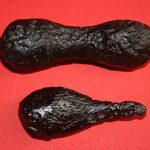
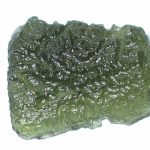
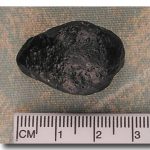
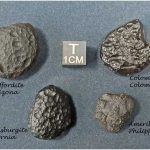

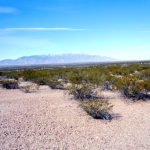




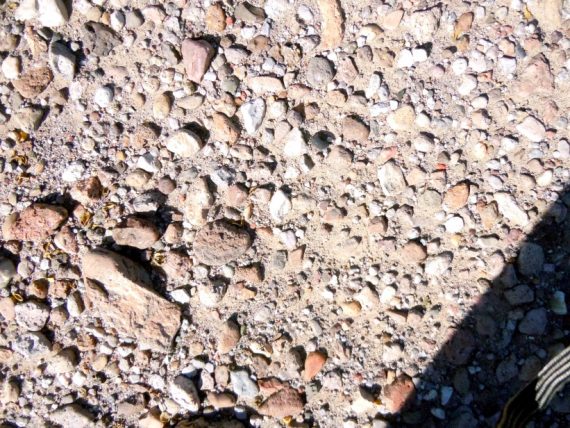
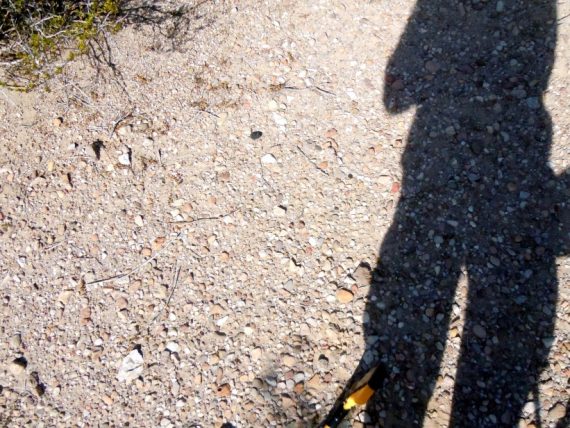
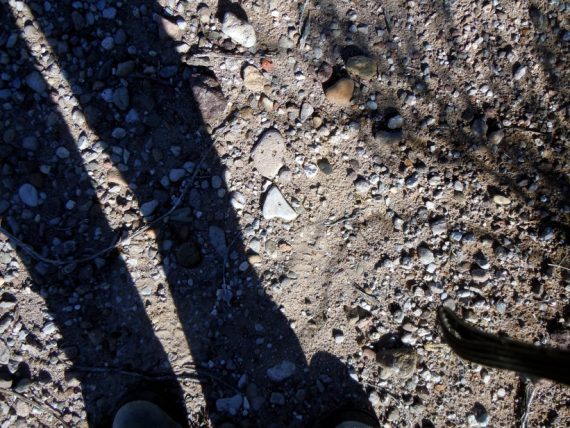






 Join the Crew!
Join the Crew!
 Escape Velocity Space News
Escape Velocity Space News
Thanks for the nice article.
I live in area where you can find moldavites. Fortunately here is a better climate (mild climate – Central Europe) and snakes don’t live on fields. The patient is important too.
Could you guess how long take to find a Saffordite (e.g one per hour or one per day)?
I know that it has been some time since you posted to this blog. However, to answer your question, we are usually in the field for three or four hours and it is not unusual to find 50 or more. Not all are the translucent ones, but finding them is not all that hard once you figure out what you are looking for.
Larry,
I live near phoenix and would love to find a saffordite .. I saw the photos and have a good idea where .. But do you have any further location info.. My daughter and I are looking for a treasure hunt!
I live in safford have dozens of them
Kurt, I hunt agates in the E. AZ desert and often stage out of Safford (I live in MN). I would love to take my grandson out to hunt for Saffordite. I’ve read all the articles I can find and have a general sense of the hunting area, but I am looking for more specific directions. Are you willing/able to help me out? Eric.
Kurt – I hunt agates in the E. AZ desert and often stage out of Safford (I live in MN). I would love to take my grandson out to hunt for Saffordite. I’ve read all the articles I can find and have a general sense of the hunting area, but I am looking for more specific directions. Are you willing/able to help me out? Eric.
I also live in the area and go hunting daily. The biggest i have found is 55g. Fun to find.
If you send me a moldavite I will send you a Saffordite !
Like Colombianites, many Saffordites show very high clarity and a pale gray color with just the slightest hint of purplish-brown in transmitted light. Some are nearly opaque, while others show banded colors. Most have a dull matte or frosted skin.
Hi, I am Kay, I live in Safford, Arizona, and run the Gila Valley Tourism Center. I am also from Minnesota. Stop in or give me a call, I would be happy to help.
Hi Kay, could we make a date to meet and hunt saffordites. I live outside Apache Junction
I would love to start my own collection and went to a different spot than you Difference between a Apache tear and a Saffordite is what
bradygoof@gmail.com do you find many of the Saffordites over 20 grams
I live in Safford! My dad just told me about these. His neighbor hunts for them. I’ve seen these all over…I had no idea!
I have found some very large opaque saffordites. One almost 4and1/2 lbs.
I am on my way to Safford and am in search of GPS coordinates or mileage down tanque rd. from Solomon.
any good place specifically to search?
I’ve been looking for buyers, can anyone help plz
I am in Safford and would like to go rock hounding if anyone would like a partner tagging along.
cynthia_anzaldua@yahoo.com
Contact me if interested. Thank you
Has anyone ever found one with color other than the black?
Yes I find the white ones. Surface similar to moldevite and white with clear surrounding
Do they study saffordites at the Vatican Observatory?